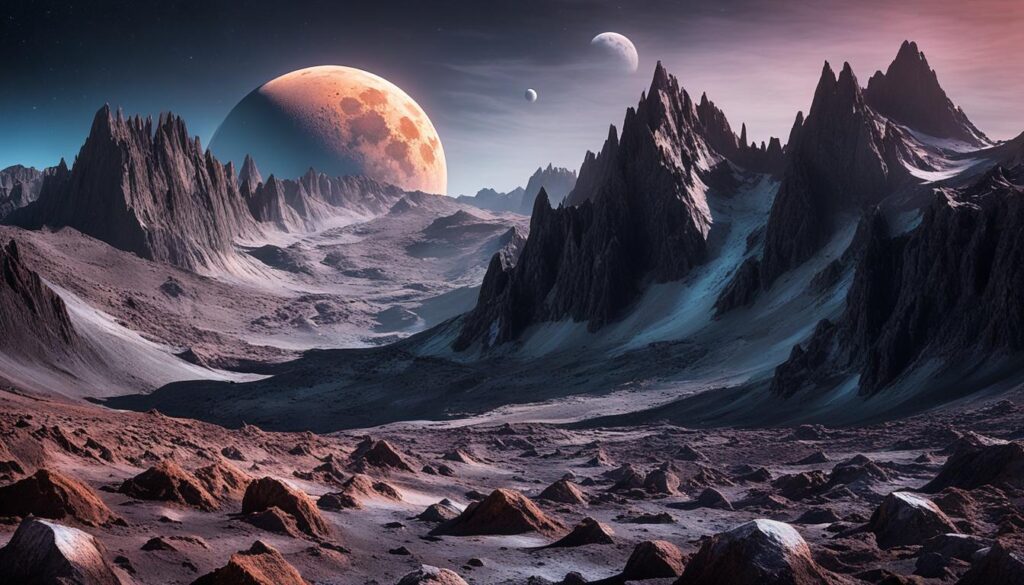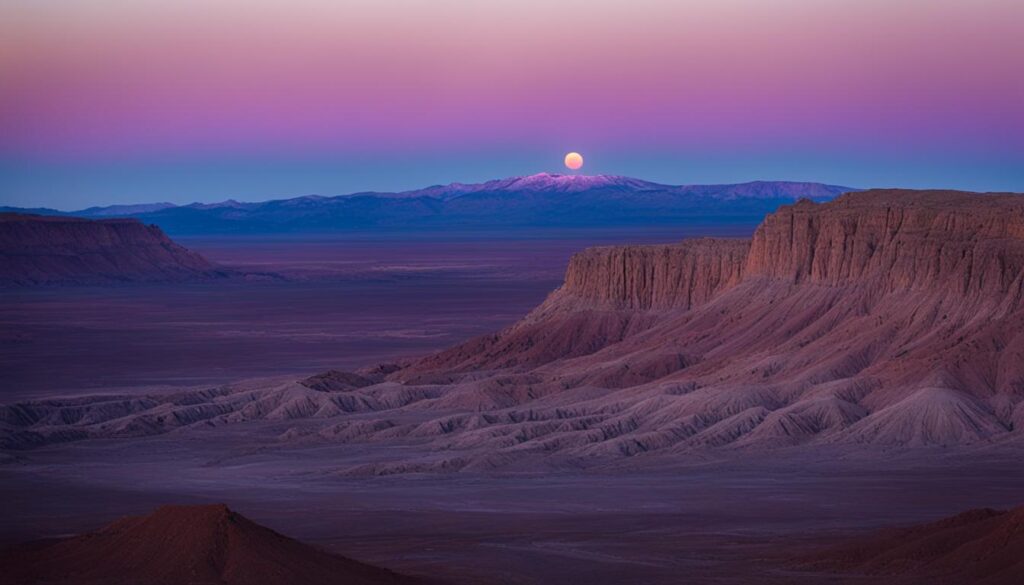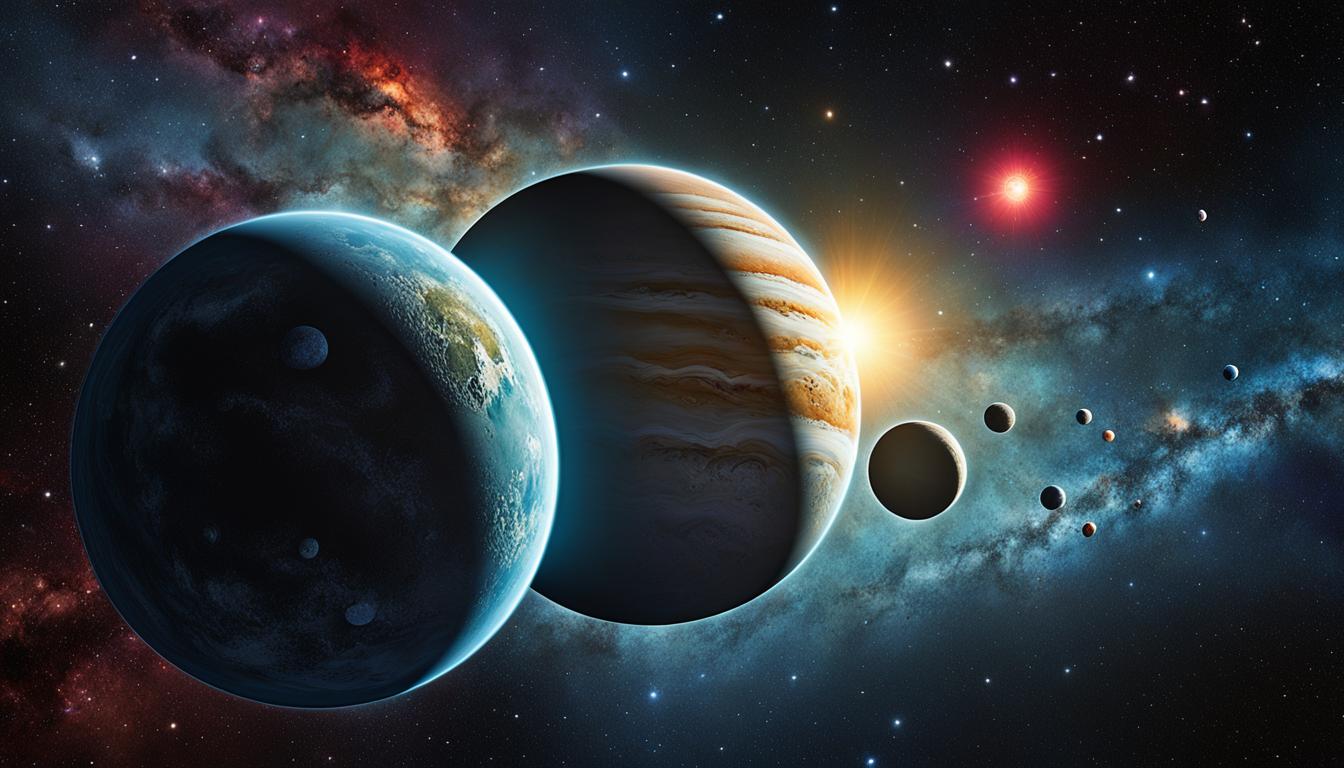Every night, as you gaze up at the stars, you can’t help but wonder about the mysteries of the universe. The planets in our solar system hold a special fascination, with their celestial beauty and intriguing features. Let’s embark on a journey through the cosmos and delve into the wonders of our planetary neighbors.
From the fiery surface of Mercury to the frigid landscapes of Neptune, each planet in our solar system has its own unique characteristics and secrets waiting to be discovered. Astronomy enthusiasts and space explorers have dedicated their lives to unraveling the mysteries of these celestial bodies.
Through planet exploration, scientists have uncovered fascinating planet facts, such as the varying sizes of these cosmic entities and their distinct planetary orbits. This knowledge allows us to classify the planets into different categories, providing us with a deeper understanding of our solar system.
Whether it’s the ethereal rings of Saturn or the colossal storms on Jupiter, the planets in our solar system captivate us with their awe-inspiring wonders. Join us on this cosmic adventure as we uncover the remarkable secrets of our celestial neighborhood.
Key Takeaways:
- Our solar system is home to a variety of captivating planets with unique features.
- Astronomy enthusiasts and space explorers have dedicated their lives to studying these celestial bodies.
- We can classify planets based on their sizes and planetary orbits.
- The planets in our solar system offer a plethora of wonders such as rings, storms, and unique landscapes.
- Exploring these planets allows us to unravel the mysteries of our solar system and gain a deeper understanding of the universe.
The Rings of Saturn
Saturn, the sixth planet in our Solar System, is widely recognized for its magnificent ring system that encircles the planet. These rings, consisting of various particles, span an impressive distance of 75,000 kilometers above Saturn’s surface, creating a visual spectacle that captures the imaginations of astronomers and stargazers alike.
Composed primarily of ice particles, the rings of Saturn reflect sunlight, illuminating the planet and providing a mesmerizing display of light and color. As sunlight passes through the rings, it undergoes scattering, resulting in the stunning hues that observers witness from Earth.
Alongside its iconic rings, Saturn is also known for its six unique crescent moons, which orbit the planet in mesmerizing synchronization. From the small and faraway Janus and Epimetheus to the intimate encounters of Tethys and Dione, these moons further enhance the celestial beauty of Saturn’s system.
Below the surface of Saturn lies a hidden wonder – a vast ocean of liquid metallic hydrogen. This unique composition, found nowhere else in our Solar System, contributes to Saturn’s distinctive characteristics and captivating presence. It is a testament to the diverse and enigmatic nature of planetary structures.
“The rings of Saturn represent a mesmerizing example of the intricate dance between celestial bodies. Their ethereal beauty serves as a reminder of the stunning wonders that await us in the vastness of space.”
As scientists continue to explore the mysteries of Saturn, they uncover astonishing details about the ring structure, the interaction between moons and rings, and the depths of liquid metallic hydrogen. These ongoing discoveries contribute to our understanding of not only Saturn but also the formation and evolution of planetary systems in the universe.
The rings of Saturn, with their sheer size and exquisite composition, showcase the awe-inspiring beauty and intricacy that exists in our Solar System. They serve as a constant reminder of the wonders that await our exploration and the countless mysteries yet to be revealed.
Jupiter’s Red Spot
Jupiter, the largest planet in our Solar System, is home to a mesmerizing and colossal phenomenon known as the Great Red Spot. This massive anticyclone has been spinning for hundreds of years, making it a captivating feature of Jupiter’s turbulent atmosphere.
The Great Red Spot is larger than Earth itself, showcasing the sheer magnitude of this swirling storm. As its name suggests, the spot appears as a deep red hue, hinting at the intensity within. The storm generates powerful lightning bolts that illuminate its tempestuous core, adding to the spectacle of this celestial wonder.
Winds within the Great Red Spot can reach astonishing speeds of over 400 kilometers per hour, contributing to the unrelenting and dynamic nature of the storm. To put it into perspective, these winds are stronger than any hurricane ever recorded on Earth. The counterclockwise rotation of the Great Red Spot completes a full cycle once every seven days, a testament to the incredible forces at play on this gas giant.
“The Great Red Spot is a mesmerizing testament to the power and turbulence found within the depths of Jupiter.”
The origins of the Great Red Spot are still not fully understood. However, this anticyclone is believed to be linked to the complex atmospheric dynamics and the planet’s enormous mass. Scientists continue to study and monitor this atmospheric feature, hoping to unlock more insights into Jupiter’s ever-changing climate and its volatile storms.
Jupiter’s Great Red Spot serves as a captivating reminder of the incredible natural phenomena that exist beyond our home planet. Its size, turbulence, and vibrant color make it one of the most recognizable features in the Solar System, fascinating astronomers and stargazers alike.
Valles Marineris, Mars
Mars, the fourth planet from the Sun, holds many wonders waiting to be discovered. One of the most awe-inspiring features of this red planet is Valles Marineris, a deep canyon that carves its way through the Martian landscape. Spanning over 2,500 miles in length, this tectonic crack is a testament to the planet’s turbulent geological history.
Valles Marineris reaches astonishing depths of up to 23,000 feet, making it one of the deepest canyons in the entire Solar System. The magnitude of this canyon is truly humbling, as it dwarfs the Grand Canyon on Earth.
Scientists believe that Valles Marineris formed as a result of both tectonic activity and water erosion. Its formation holds clues about Mars’ ancient past and the dynamic forces that have shaped its surface. The canyon’s intricate network of fractures and cliffs provides valuable insight into the planet’s geological evolution.
As the sun sets over Valles Marineris, a mesmerizing icy mist envelops the deep canyon, creating a surreal and breathtaking spectacle. The interplay of light and mist paints the Martian landscape with an ethereal beauty that captivates the imagination.
Explorers and future astronauts who venture into Valles Marineris would witness not only the vastness of this geological marvel but also the potential for scientific discoveries. This deep canyon holds secrets that could shed light on Mars’ past habitability and the potential for future colonization.
The Geysers of Enceladus
Enceladus, one of Saturn’s moons, is a fascinating world with erupting geysers. Huge ice plumes shoot through its surface, propelling ice crystals into space at astonishing speeds. These geysers, illuminated by the distant sun, are one of the highlights of this moon. Exploring Enceladus would require precautions due to its low gravity and the presence of powerful geysers. This icy moon offers a glimpse into the diverse and dynamic nature of Saturn’s satellite system.
If you ever had the chance to visit Enceladus, you would witness a truly spectacular sight. Imagine standing on the surface, surrounded by towering geysers, as they shoot icy plumes high above you. The distant sun’s light glistens off the sparkling ice crystals, creating a mesmerizing display unlike anything on Earth. This captivating phenomenon is a reminder of the astonishing beauty and complexity of our universe.
“The geysers of Enceladus are a testament to the sheer power and dynamism of Saturn’s moon. Exploring this icy world would provide invaluable insights into the processes shaping our celestial neighborhood.” – Dr. Elizabeth Johnson, Space Exploration Scientist
As we continue to push the boundaries of space exploration, Enceladus holds great potential for scientific discoveries. The ice plumes ejected from its geysers could provide valuable samples for analysis, potentially revealing insights into the moon’s composition and the presence of organic compounds. Additionally, studying the geysers’ behavior could enhance our understanding of geological processes and the role of subsurface oceans in sustaining habitable environments.
Did you know? Enceladus’ geysers were first discovered by the Cassini spacecraft during its mission around Saturn. This groundbreaking discovery transformed our understanding of this enigmatic moon and sparked further interest in exploring its mysteries.
If future space missions successfully land on Enceladus, scientists and astronauts would need to take extraordinary precautions. The low gravity combined with the powerful geysers could make landing and maneuvering on the moon’s surface challenging. However, the scientific rewards of such a mission would be immeasurable, offering a wealth of knowledge about Saturn’s moon and the potential for extraterrestrial life.
Exploring the Geysers of Enceladus
- Studying the composition of ice plumes to understand the moon’s geology
- Searching for organic compounds that could indicate the presence of life
- Investigating the dynamics and behavior of the geysers for insights into subsurface oceans
- Examining the effects of Enceladus’ gravity on geysers’ eruption patterns
- Assessing the potential for future human exploration or colonization
The Geysers of Triton
Discover the intriguing world of Triton, the largest moon of Neptune, where smoky-looking cryogeysers create a mesmerizing spectacle. These geysers, composed of nitrogen frost and dark organic compounds, shoot up to 8,000 meters into the thin atmosphere of Triton. The sound of these eruptions reverberates for kilometers, adding to the otherworldly experience.
Triton’s extreme cold temperatures and unique geological activity make it a place of alien beauty. As you explore this mysterious moon, you’ll be captivated by the ethereal sight of the smoky cryogeysers rising against the backdrop of Neptune’s vast expanse.
“The cryogeysers of Triton are a fascinating natural phenomenon that showcases the interplay between nitrogen frost and organic compounds. They offer a glimpse into the complex geology of this moon and the dynamics of its thin atmosphere.” – Dr. Sarah Thompson, Planetary Geologist
Unique Geological Activity
Triton’s cryogeysers are a testament to the diverse geological activity occurring on this moon. The combination of nitrogen frost and dark organic compounds creates the smoky appearance of the geysers, adding to the mystique of Triton’s landscape. The eruptions provide valuable insights into the moon’s complex composition and the processes at work beneath its surface.
Musical Eruptions
The eruptive nature of Triton’s cryogeysers goes beyond their visual beauty. The sound generated by these powerful eruptions can be heard from kilometers away, creating a symphony of natural rhythms. This auditory experience adds another dimension to the exploration of Triton, immersing you in its otherworldly environment.
An Otherworldly Destination
With its nitrogen frost-covered surface and organic compound-rich geysers, Triton offers a unique destination for space exploration. As you gaze upon the towering cryogeysers and immerse yourself in the moon’s mysterious atmosphere, you’ll be transported to a place of both scientific curiosity and wonder.
- Experience the awe-inspiring sight of cryogeysers shooting up to 8,000 meters into Triton’s atmosphere.
- Listen to the sound of these musical eruptions reverberating across the moon’s surface.
- Delve into the captivating geological activity and unique composition of nitrogen frost and organic compounds.
Embark on a journey to Triton, Neptune’s enigmatic moon, and witness the breathtaking beauty of its smoky cryogeysers. As you explore this fascinating world, you’ll uncover the secrets of its geological activity and marvel at the wonders of our Solar System.
Peaks of Eternal Light
On our own Moon, there are unique areas called the peaks of eternal light where the sun never sets. These regions, found on the lunar surface near the north pole, remain bathed in sunlight due to the Moon’s axial tilt and orbit around the Earth. These peaks could potentially serve as ideal spots for a future moon base, with stable temperatures and the possibility of water ice. The peaks of eternal light are a testament to the mysteries and potential of our closest celestial neighbor.

Imagine standing on one of these lunar peaks, overlooking the vast lunar landscape illuminated by perpetual sunlight. The serene beauty of the moon’s surface, untouched by the darkness of night, creates a surreal experience for future explorers.
The perpetual sunlight not only provides a constant source of energy but also offers the possibility of harnessing solar power for various lunar base operations. With reliable access to sunlight, researchers and astronauts can conduct experiments, grow plants, and generate electricity, opening up new opportunities for sustainable living on the Moon.
“The peaks of eternal light on the Moon represent a promising location for establishing a moon base. The stable temperatures and continuous sunlight make these regions ideal for long-term human habitation and scientific research.” – Dr. Jane Rodriguez, Lunar Exploration Expert
Furthermore, the peaks of eternal light offer a potential source of water ice. Recent discoveries have revealed the presence of water molecules in the permanently shadowed craters near these sunlit peaks. Water is a valuable resource in space exploration, and its availability on the moon could support future missions and serve as a critical supply for sustaining life.
As we continue to explore and unlock the mysteries of the Moon, the peaks of eternal light stand as beacons of potential for human presence and scientific advancement. These unique regions on our lunar companion hold the promise of a future moon base, where researchers, astronauts, and explorers can unravel the secrets of the Moon while braving the endless daylight.
Key Highlights
- The peaks of eternal light on the Moon are areas where the sun never sets, located near the lunar north pole.
- These sunlit regions offer stable temperatures and perpetual sunlight, making them ideal for future moon base locations.
- Continuous access to sunlight enables the generation of solar power and supports various lunar base operations.
- The peaks of eternal light may contain water ice, a valuable resource for sustaining life and supporting exploration.
Herschel Crater on Mimas
Explore the wonders of Mimas, one of Saturn’s many captivating moons. Nestled within Mimas lies the awe-inspiring Herschel Crater, an impact crater that stretches an impressive 139 kilometers in diameter. This remarkable crater features a towering peak that rises over 6,000 meters above the basin’s floor.
Imagine standing on this majestic peak, taking in the breathtaking views of the expansive crater and the surrounding lunar landscape. The Herschel Crater serves as a testament to the violent impact events that have shaped the moons of our Solar System, leaving behind intriguing features that continue to captivate astronomers and researchers alike.
“The Herschel Crater on Mimas showcases the power and beauty of celestial impact events, offering a glimpse into the dynamic nature of our Solar System.”
Uncover the mysteries of Mimas and behold the grandeur of the Herschel Crater, a testament to the cosmic forces that have shaped our celestial neighborhood.
Sunrise on Mercury
Mercury, the closest planet to the Sun, offers a mesmerizing spectacle of sunrise and sunset. Due to its slow rotation and elliptical orbit, the sun appears to go through a unique dance in the sky.
Imagine this: as the sun rises on Mercury, its dazzling light captures the horizon. But then, something extraordinary happens. The sun seems to pause, as if savoring the moment, before reversing its path and moving back toward the rising horizon. The celestial ballet continues as the sun stops once again, teasing the onlooker, before finally setting below the horizon.
This captivating phenomenon is a result of Mercury’s elliptical orbit around the Sun. Due to the planet’s proximity to its star, the gravitational pull and orbit shape cause the sun’s apparent motion to behave differently from what we experience on Earth.
Watching the sunrise on Mercury is a rare and awe-inspiring experience. The sun’s delicate movements against the backdrop of Mercury’s barren landscape create a breathtaking aerial display. It is a testament to the intricate interplay between celestial bodies, where even seemingly simple moments become extraordinary.
“The beauty of the sunrise on Mercury lies not only in its visual grandeur but also in the scientific insights it offers. Studying the planet’s orbit and how it affects the sun’s apparent motion can provide valuable clues about the dynamics of our solar system.” – Dr. Sarah Baker, Astrophysicist
So, if you ever find yourself on an interstellar journey, make sure to witness the sunrise on Mercury. It will be a memory that lasts a lifetime, an ethereal moment that reminds us of the wonders that lie beyond our own terrestrial realm.

Conclusion
Embarking on a journey to explore the wonders of planets in our Solar System is an awe-inspiring experience. From the magnificent rings of Saturn to the mysterious canyons of Mars, each celestial body offers a unique perspective on the celestial beauty that surrounds us. Through exploration, we have unveiled scientific discoveries that have deepened our understanding of the vastness and intricacies of the universe.
As we continue to delve into the mysteries of the solar system, our appreciation for its wonders grows. The celestial beauty of these planets serves as a constant reminder of the endless possibilities that await us in the cosmos.
Exploration has always been at the heart of human nature. By venturing beyond our own planet, we push the boundaries of knowledge and embark on a journey of scientific discovery. The wonders of the solar system have captivated and inspired generations of astronomers, scientists, and space enthusiasts, and they continue to fuel our curiosity and drive for exploration.
So, let us continue to explore, learn, and marvel at the wonders of the planets in our Solar System. Through scientific discoveries, we unlock the secrets of the universe and gain a deeper understanding of our place within it.

